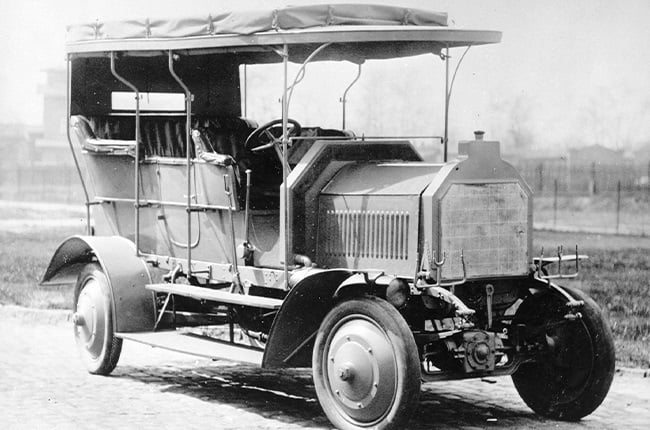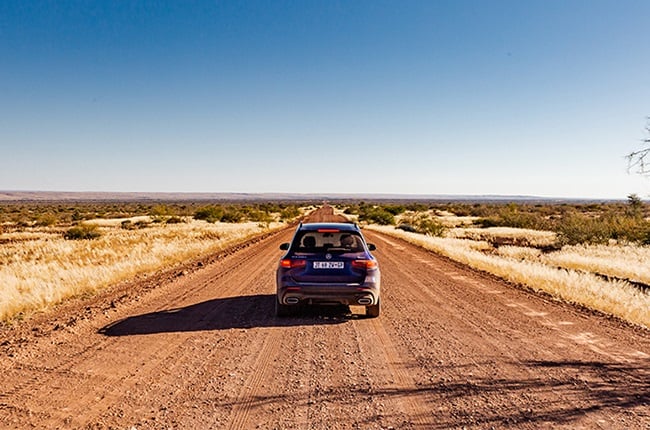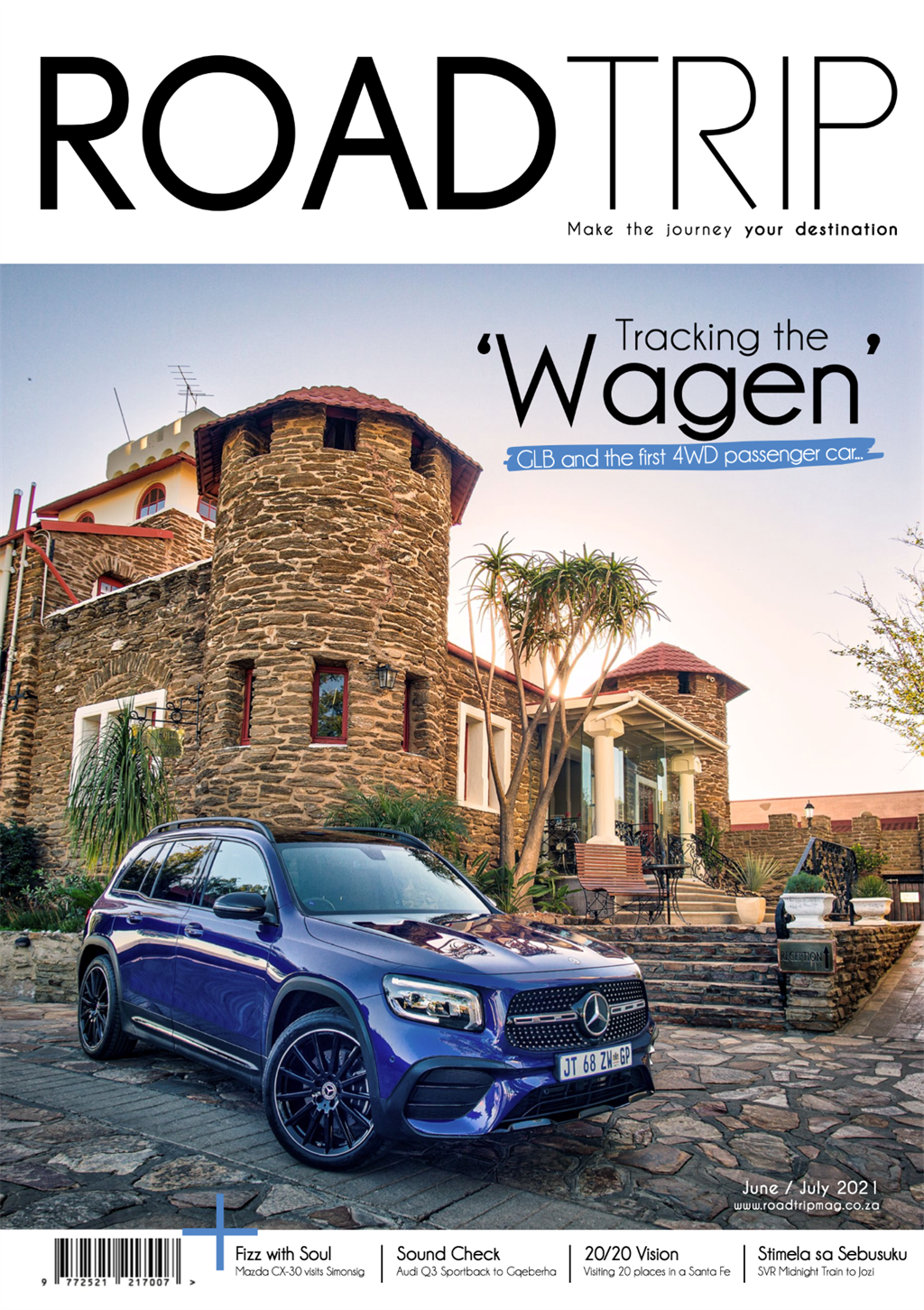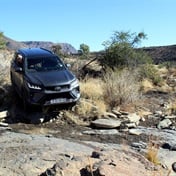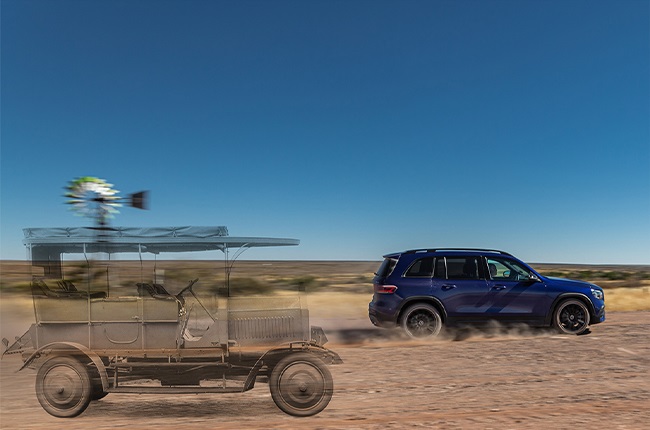
• The 'Dernburg Wagen' was the first all-wheel drive passenger car.
• The RoadTrip team tracks the car's heritage in Namibia in the Mercedes-Benz GLB.
• The trip included plenty of driving on both gravel and tar.
• For more motoring stories, go to Wheels24
I have come to know Keetmanshoop very well. Having spent hours trying to find an elusive can of AdBlue additive in this city in the Karas region of Southern Namibia, I now know where every fuel station (there are six), wholesaler, hardware store, and lubricant supplier in town is.
Heck, I even know most of the owners' names and have their cell numbers stored on my 'phone. All because the electronic system on our Mercedes-Benz GLB 220d 4Matic decided to shut down the vehicle as its supply of AdBlue (it converts NOx from diesel engines into harmless nitrogen and steam) was depleted.
The mention of AdBlue was met with blank stares all around, and it was soon clear none of this substance was available in this part of Namibia. By now, we have already contacted Mercedes On Call and were duly informed the only supply of AdBlue in Namibia was in Windhoek - 700km to the North. Ironically, we were in Windhoek the previous day but have not realised we may face a potential problem.
Anyway, in the end, it meant a Mercedes Benz technician had to drive from the Namibian capital to Keetmans to bring the stuff. We (again) checked into the Schützenhaus Guest House during our six-hour wait - from where we started our journey the day before.
The 'Dernburg Wagen'
The rationale for our trip was a vehicle built by the Daimler-Motoren-Gesellschaft (DMG) in 1907 that later became known as the 'Dernburg Wagen'. Designed by Paul Daimler, son of the company's founder, it was the first all-wheel-drive car for everyday use in the world.
The vehicle, built to requirements from the German Colonial Office, was 4.9m long, had a wheelbase of 4m, a track width of 1.42m, and ground clearance of 320mm (not uncommon back then). It stood tall at 2.70m (including the roof structure) and weighed nearly 3.6 tonnes when fully laden with all the extraordinary items specified by the Colonial Office.
READ: RoadTrip | A prancing horse? Tracing the roots to Toyota's first emblem in the new Fortuner
It was fitted with a seven-seat touring car body (two seats on the chauffeur's bench and four in the rear), and it had a sunshade mounted on eight poles. A large luggage rack was mounted on the roof, plus there is a luggage rack at the rear used to carry spare tyres. Awnings affixed below the roof could be lowered to protect the occupants from wind, weather, and sand.
Powered by a huge 6.8-litre four-cylinder engine delivering 26kW at 800rpm, it could achieve around 40 km/h on level tarmac. The engine delivered power to the four wheels via a sophisticated mechanical system, giving the vehicle outstanding climbing ability. It also had rear-wheel steering to achieve a reasonable turning circle.
The vehicle was subjected to a thorough trial in Germany before it was shipped to Swakopmund in May 1908 on board the steamer "Kedive". In June, it was delivered to Bernhard Dernburg, the then Secretary of State at the German Colonial Office, and thanks to all his travels in the all-wheel-drive colossus, it was nicknamed the 'Dernburg-Wagen'.
Tracking the route
Using the vehicle for official trips, Dernburg and his party crisscrossed the vast expanses of Namibia before it was presented to the local police permanently. The trips also served as a general test for motor vehicles in difficult colonial conditions. A precise log was kept, indicating that the vehicle had already covered around 10 000km by early 1910.
One travel report described a journey with the Dernburg: "The 600 km trip from Keetmanshoop via Berseba to Gibeon, and then from Maltahöhe, Rehoboth to Windhoek was completed in four days without incident. This is a big time-saving, as the same journey will take an accomplished rider twelve days on horseback."
Mobile communication was possible too, according to the report: "When [the vehicle] was carrying Secretary of State Dernburg, a field telephone was taken along that could be tapped into the telegraph wires along the way."
READ: RoadTrip | A tale of two lions - What Peugeot's logo is all about and the new 2008 SUV
With the above in mind, we decided to reenact the trip with the latest SUV from Daimler AG, the compact Mercedes GLB. Introduced locally late last year, the GLB is also the first Mercedes Benz in the compact class optionally available as a seven-seater.
After acquiring a GLB 220d 4Matic for our expedition, we set off from Cape Town. Crossing the border was seamless, and soon we were at the Schützenhaus Guest House in Keetmanshoop. Established in 1907, the guesthouse is on the premise of the oldest German club in Southern Africa, and we are sure Herr Dernburg stayed over at the club during his travels in "Südwest".
This was confirmed over a beer (and many a red cross, actually Unicum, a Jägermeister type herbal drink from Hungary) by owner Ingo Klitzke, who privatised the club after 98 years and converted it into a guesthouse. According to Klitzke: "There was no other accommodation available here back then, so yes, it is most likely."
Keetmanshoop to Rehoboth, on dirt
We departed the following day, taking the D609 dirt road towards Berseba, diverting onto the D3903 towards Gibeon with its beautiful church before following the route towards Maltahöhe.
Our blue GLB, looking smart with its AMG Line trim, may be 100mm longer than the new B-Class, yet it is still nearly a metre shorter than the erstwhile Dernburg, and much lower.
Still, it has lots of legroom in the rear, and people of up to 1.68m tall can be seated comfortably in the two optional seats at the back (our car had a five-seat configuration). The rear seat row can also be moved fore and aft by 140mm, enabling the boot (with electric rear door) to be enlarged from 507L by up to another 190L. The torque-happy 2.0-litre turbodiesel, delivering 140kW and 400Nm from 1 600rpm, warranted rapid progress on the undulant dirt roads. However, the low profile 20-inch tyres on AMG rims was a concern (there is only a space-saver spare tyre), so we kept the speed down while admiring the beautiful surroundings.
READ: RoadTrip | Traversing the rain-soaked Kalahari Red Dune Route in Lexus' hybrid RX450h
Namibia was greener than even the bushveld and teeming with birds and wildlife with the yellow sand bedecked with grass after good rains. We even had to carefully negotiate some shallow water splashes and sandy, muddy, sections but the 4Matic system handled this easily. Even the low ground clearance of the GLB (200mm) was no problem.
After joining the tarred C19, we stopped in Maltahöhe for a quick coffee break. From there, it was a two-hour trek towards Kalkrand before we got back onto the B1 national road to Rehoboth, and by early afternoon we were in Windhoek. Our roundabout journey took around six hours compared to the four days with the 'Dernburg Wagen'.
Losing the trail
We visited the Heinitzburg Castle in Windhoek - now a hotel owned by the Raith family - and enjoyed cappuccinos on the broad terrace with a stunning birds-eye view of the city. The castle, one of three in the city, was built in 1914 by architect Wilhelm Sander and then sold to Hans Bogislav Graf von Schwerin, who named it Heinitzburg, after his wife Margarete's birth surname, "Von Heinitz".
We are sure the Dernburg, by then possibly driven by a police commissioner, also graced the steep pathway of the castle. But what became of it?
As was common practice at the time, the driver of the car, who also doubled as the mechanic, was sent along with the vehicle. Thus, when the car was handed to the police, driver Paul Ritter was duly sworn in as a policeman. After Dernburg's departure, Ritter remained in the country to look after the car. The machine proved its worth on sandy surfaces, but it was too heavy, and the police wanted to convert it to a two-wheel drive.
Whether this happened is unclear, and it is also unknown how the car was used during the First World War. After the war, in 1919, Ritter returned to Germany, and all trace of the 'Dernburg' was lost. Its fate is still unknown.
Tech blues
Having retraced the 'Dernburg' route, we headed back South the next day. But by now, messages started to flash on the cockpit display, telling us the AdBlue in the diesel GLB was low. Initially, we did not pay much attention, but it became insistent, indicated we had less than 500 km left before we needed to refill.
With over 700km still to drive, we realised we would have to fill up before we reached the border, and in Keetmanshoop, the computer indicated we had only 30km left before complete shutdown. So, on a Saturday in Keetmanshoop, I started my futile search for AdBlue.
READ: RoadTrip | Match made in heaven - Visiting the Sappi Forests in Subaru's new Forester
Journeys with the 'Dernburg Wagen' also did not always go smoothly, primarily due to its huge weight destroying its primitive pneumatic tyres. With the amount of off-road driving done, they did not last long. And by 1910, the car had used 36 tyres and 27 inner tubes.
So, lessons learnt, besides extra tyres, take a can of AdBlue (or at least check the levels, as our GLB took nearly 20 litres!) before leaving on a long trip to some remote destination in your diesel Mercedes Benz (or any diesel car from Europe, for that matter).
Oh, and lookout for a rusted pile of engine scrap coupled with an ancient four-wheel-drive system lying on a Namibian farm somewhere. It may be worth a fortune.
Engine: 1 950 cc inline 4 turbodiesel
Power: 140kW @ 3 800rpm
Torque: 400Nm @ 1 600 2 600rpm
Transmission: 8G DCT, 4Matic 4×4
0-100km/h: 7.6 seconds
Top speed: 217 km/h
Fuel capacity: 60L
Fuel economy: 5.4-litres/100km (claimed)
CO2 emissions: 144 g/km
Price: R841 000 (without options)
We like
Strong, torque happy engine, smooth ride, roomy interior, baby GLS looks.
We do not like
Some wind noise around mirrors, expensive options list, do not forget the AdBlue!
RoadTrip rating: 85%




 Publications
Publications
 Partners
Partners





